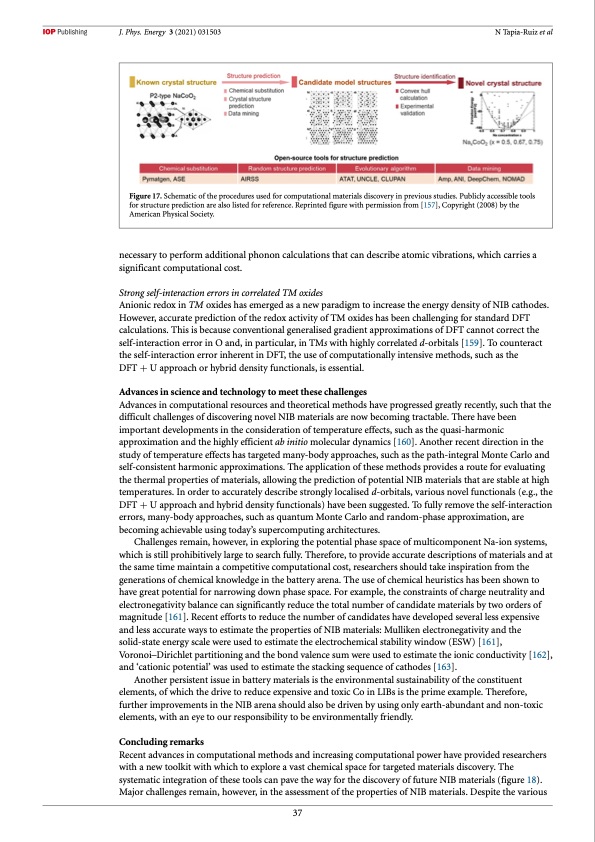
PDF Publication Title:
Text from PDF Page: 038
J. Phys. Energy 3 (2021) 031503 N Tapia-Ruiz et al Figure 17. Schematic of the procedures used for computational materials discovery in previous studies. Publicly accessible tools for structure prediction are also listed for reference. Reprinted figure with permission from [157], Copyright (2008) by the American Physical Society. necessary to perform additional phonon calculations that can describe atomic vibrations, which carries a significant computational cost. Strong self-interaction errors in correlated TM oxides Anionic redox in TM oxides has emerged as a new paradigm to increase the energy density of NIB cathodes. However, accurate prediction of the redox activity of TM oxides has been challenging for standard DFT calculations. This is because conventional generalised gradient approximations of DFT cannot correct the self-interaction error in O and, in particular, in TMs with highly correlated d-orbitals [159]. To counteract the self-interaction error inherent in DFT, the use of computationally intensive methods, such as the DFT + U approach or hybrid density functionals, is essential. Advances in science and technology to meet these challenges Advances in computational resources and theoretical methods have progressed greatly recently, such that the difficult challenges of discovering novel NIB materials are now becoming tractable. There have been important developments in the consideration of temperature effects, such as the quasi-harmonic approximation and the highly efficient ab initio molecular dynamics [160]. Another recent direction in the study of temperature effects has targeted many-body approaches, such as the path-integral Monte Carlo and self-consistent harmonic approximations. The application of these methods provides a route for evaluating the thermal properties of materials, allowing the prediction of potential NIB materials that are stable at high temperatures. In order to accurately describe strongly localised d-orbitals, various novel functionals (e.g., the DFT + U approach and hybrid density functionals) have been suggested. To fully remove the self-interaction errors, many-body approaches, such as quantum Monte Carlo and random-phase approximation, are becoming achievable using today’s supercomputing architectures. Challenges remain, however, in exploring the potential phase space of multicomponent Na-ion systems, which is still prohibitively large to search fully. Therefore, to provide accurate descriptions of materials and at the same time maintain a competitive computational cost, researchers should take inspiration from the generations of chemical knowledge in the battery arena. The use of chemical heuristics has been shown to have great potential for narrowing down phase space. For example, the constraints of charge neutrality and electronegativity balance can significantly reduce the total number of candidate materials by two orders of magnitude [161]. Recent efforts to reduce the number of candidates have developed several less expensive and less accurate ways to estimate the properties of NIB materials: Mulliken electronegativity and the solid-state energy scale were used to estimate the electrochemical stability window (ESW) [161], Voronoi–Dirichlet partitioning and the bond valence sum were used to estimate the ionic conductivity [162], and ‘cationic potential’ was used to estimate the stacking sequence of cathodes [163]. Another persistent issue in battery materials is the environmental sustainability of the constituent elements, of which the drive to reduce expensive and toxic Co in LIBs is the prime example. Therefore, further improvements in the NIB arena should also be driven by using only earth-abundant and non-toxic elements, with an eye to our responsibility to be environmentally friendly. Concluding remarks Recent advances in computational methods and increasing computational power have provided researchers with a new toolkit with which to explore a vast chemical space for targeted materials discovery. The systematic integration of these tools can pave the way for the discovery of future NIB materials (figure 18). Major challenges remain, however, in the assessment of the properties of NIB materials. Despite the various 37PDF Image | 2021 roadmap for sodium-ion batteries

PDF Search Title:
2021 roadmap for sodium-ion batteriesOriginal File Name Searched:
roadmap-sodium-ion-batteries_031503.pdfDIY PDF Search: Google It | Yahoo | Bing
Salgenx Redox Flow Battery Technology: Salt water flow battery technology with low cost and great energy density that can be used for power storage and thermal storage. Let us de-risk your production using our license. Our aqueous flow battery is less cost than Tesla Megapack and available faster. Redox flow battery. No membrane needed like with Vanadium, or Bromine. Salgenx flow battery
| CONTACT TEL: 608-238-6001 Email: greg@salgenx.com | RSS | AMP |